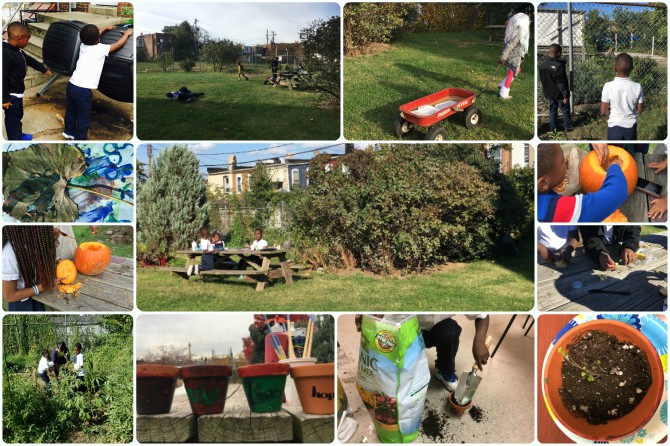As a Sierra Club intern at Amazing Grace Lutheran Church’s garden in East Baltimore, I spent the last three months teaching a fun bunch of elementary school kids at the church’s after-school program about gardening, food, and the environment around them. The community garden, which is located directly behind the church, served as our outdoor classroom, the picnic table in the center as our desk. It was fantastic to spend the last days of summer and this very mild autumn outside, using the living, breathing environment as our blackboard.
One afternoon we ate apples and then checked out the garden’s apple trees. Another afternoon, we snacked on grapes – a definite favorite – and learned that grapes grow on vining plants that climb unto surrounding structures. We then made art with giant grape leafs. We carved a pumpkin in October; with its squishy innards up to our elbows, we talked about the different growing seasons and the numbers of ways people eat pumpkins. Though most of my kids were not fans of the roasted pumpkin seeds I brought for them to sample the next week, they did enjoy a slice of pumpkin pie.
Other days, my “lesson plans” were derailed by that insatiable desire to just play. On Halloween Day, candy-powered kids donned costumes and ran around the garden chasing each other, role-playing Ninja Turtles and Batmans and Scary Ghouls. And other days, I got to capture all that energy in makeshift “Who Can Spin the Compost Barrel the Most Times?” competitions, right after we had put our snack remnants in the heavy container.
Amazing Grace’s community garden is part of the Amazing Port Street Commons, a revitalized environmental green space that used to be filled with neglected rowhouses. The Commons boasts pollinator plants and a rain garden, in addition to the food-producing garden that I worked in. A field of grass, a reflection maze, and a public bench under a shady tree provide critical access to green space to McElderry Park residents. Despite the name of the neighborhood, McElderry Park ironically does not actually have a nearby park.
Jennifer Kunze, Sierra Club volunteer and former Environmental Programs Organizer at Amazing Grace church says that it is important to note that, “Although we have the vegetable garden enclosed, all of the green space in the Commons that isn't related to food production is unfenced and open to the public.” The Amazing Port Street Commons is an oasis of vibrant green and living things in a heavily urbanized area.
Amazing Grace Pastor Gary Dittman describes the Amazing Port Street Commons as a “healing place.” Though he acknowledges the community’s tangible hardships, he has tremendous faith in the greenery of the Commons as a place that reminds the neighborhood “good things will grow” from it. It is a place of hope and promise.
The Amazing Port Street Commons is owned by local Charm City Land Trusts, a community land trust which acts as a “steward” of the space. Its ownership ensures that the Commons will continue to be developed fairly and with the community’s ultimate benefit in mind.
This is an important fact to understand. A number of gardens in Baltimore’s burgeoning urban farming scene are located on land that gardeners and caretakers do not actually own through the city’s “Adopt-a-Lot” program. Though the program allows individuals to legally build gardens on formerly abandoned lots, it fails to protect the revitalized space from being bought by private developers.
Ms. Kunze emphasizes that these gardens thereby exist in a “precarious state.” Gardeners of Adopt-A-Lot spaces continuously improve and add value to the community, while being fully aware of the risk of the adopted property being taken away. The Filbert St. Garden, another Sierra Club garden partner I wrote about here, is one such garden that exists through the Adopt-a-Lot program. But since the Amazing Port Street Commons is owned by a land trust, it is controlled by the community and will be preserved as a green space no matter what development may come to the neighborhood.
Working at Filbert St. and Amazing Grace’s garden has shown me, first hand, their importance to the communities they serve. These spaces not only grow food, they also give adults and kids alike equitable access to green space to learn from and to play on. I am relieved to know that – thanks to the work of Charm City Land Trusts - the Amazing Port Street Commons will be there next year blooming with opportunity, taking care of the next batch of after-school children, and inspiring the breathless teacher running after them.
If you are interested in learning more about Charm City Land Trusts, check them out here.
